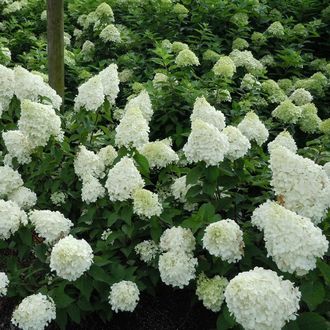Content
- 1 The best varieties of cucumbers
- 2 Review of the best varieties of cucumbers for greenhouses for 2017-2018
- 3 Cucumber varieties for greenhouses according to various characteristics
- 4 Reviews of gardeners about cucumbers for greenhouses for 2017-2018
- 5 The best varieties of cucumbers for greenhouses and greenhouses
- 6 The best varieties of cucumbers for open ground
- 7 The best cucumber varieties for shady areas
- 8 The best varieties of cucumbers for balconies and home gardens

cucumber April F1
Using my many years of experience in growing cucumbers in a greenhouse and open field, as well as having studied the reviews of other gardeners on the forums and numerous neighbors in the garden, I can confidently advise you to plant the best varieties and hybrids of cucumbers. They are suitable for growing both in greenhouses and under temporary cover films and in open ground. Each gardener chooses what suits him best.
Of course, for a greenhouse, it is better to take hybrid varieties of F1 cucumbers, since they have short side lashes and do not need to be pinched. Hybrids tend to have high yields and disease resistance.
If you choose varieties of cucumbers for the Urals and Siberia, then consider varieties and hybrids that bear fruit well in low light conditions and are cold-resistant.
If you plant cucumbers in a greenhouse or greenhouse that require pollination by bees, do not forget that from the beginning of flowering, bees should have free access to flowers.
Cucumber varieties with photos and descriptions, reviews
Cucumbers Herman F1
An early, high-yielding parthenocarpic hybrid with a long fruiting period. The plant is powerful, with sufficient nutrition it simultaneously forms up to 6-7 fruits in one node. Fruits are green, dense, large tuberous, gherkin type, genetically without bitterness.
The hybrid is resistant to cladosporia, powdery mildew and cucumber mosaic virus. It is grown both in greenhouses and in the open field in vertical and horizontal ways.
Productivity of cucumbers Herman: up to 9 kg per plant per season (subject to timely watering and feeding).
Cucumbers Masha F1
The earliest (37-39 days before fruiting), parthenocarpic hybrid. The fruits are standard in size, 8-11 cm long, ripen together, have a very attractive appearance. They are good both fresh and salted.
The hybrid is resistant to cucumber mosaic virus, cladosporiosis, powdery mildew, relatively resistant to downy mildew.
Productivity of cucumbers Masha: more than 10 kg of fruits per 1 sq. meter of landings.
One of my favorite cucumbers.
Cucumbers Connie F1
An early high-yielding parthenocarpic (not requiring pollination) hybrid of the gherkin type, 43-45 days pass from germination to the beginning of fruiting. The plant is medium-growing, with a bundle formation of ovaries.
Cucumbers are short, cylindrical, 7-9 cm long and weighing 60-80 grams, bright green, small-tuberous, white-thorn. Crispy, juicy, without bitterness, with excellent taste. The hybrid is resistant to overgrowth, powdery mildew and root rot.
Connie F1 is a multipurpose cucumber used for fresh consumption and for processing. Recommended for growing in open and protected ground.
Connie's cucumber yield: 14 - 16 kg / m².
Cucumbers Courage F1
Early ripening parthenocarpic hybrid (from germination to fruiting 45-50 days), female flowering type, intended for cultivation in greenhouses.
The plant is vigorous, with medium shoots. In the nodes, 2-4 ovaries are formed (often up to 5-6 ovaries).
Fruits are dark green with light stripes, 12-15 cm long, weighing 120-130 grams, lumpy, white-thorn, universal use. Taste quality is high, without bitterness. Planting density 2.5-3.0 plants per sq. meter. The hybrid is relatively resistant to the main diseases of the cucumber.
Cucumber yield Courage: 6-8 kg / plant.
Cucumbers Nezhinsky 12
One of the best pickling varieties. It is grown in open ground and in film shelters. The variety is mid-season, bee-pollinated, unpretentious, disease-resistant. Long-leaved bush.
Cucumbers are short, elongated-ovoid, large-tuberous, black-spiky, 10-12 cm long, weighing 80-110 grams. The flesh of the fruit is crispy and has excellent taste. The variety is resistant to olive spot and bacteriosis.
Productivity of cucumbers variety Nezhinsky 12: 1.5 - 2 kg / sq. m.
Agricultural technology: at the end of May, seeds are planted in greenhouses and in the ground, or 20-25 day old seedlings. Planting density - 3 plants per 1 sq. M. The seeding depth is 1.5-2 cm. The soil should be fertile with high aeration (sawdust, leaves can be added).
Cucumbers Miranda F1
Early maturing, high-yielding, versatile hybrid, with a well-pronounced parthenocarp of a predominantly female flowering type. These cucumbers are intended for cultivation in foil greenhouses and open field. The plant is vigorous, well leafy, in a node from one to two ovaries.
Cucumbers 11-12 cm long, weighing 110-120 g, cylindrical in shape with white thorns, green color with white dots throughout the greenery and stripes up to the middle of the fruit. The fruits are juicy, aromatic, good both in salads and for any processing, especially in salting.
Hybrid advantages: has increased cold resistance and group resistance to diseases, including powdery mildew, early maturity.
Productivity of Miranda cucumbers: up to 6.3 kg / sq. m.
Sowing: seeds or 25-35 day old seedlings are planted in unheated greenhouses or in the ground at the end of May, when the soil warms up to 14-15 ° С. Planting density: when grown in spread - 3-4 plants / 1 m², vertical production on stakes / trellises - 2-3 plants / 1 m². The seeding depth is 1.5-2 cm.
Cucumbers Ira F1
An ultra-early maturing bee-pollinated hybrid of a predominantly female flowering type, from germination to the beginning of fruiting 45-50 days. The plant is medium-growing, in one node there are 2-3 ovaries.
Cucumbers are cylindrical, 12-15 cm long, weighing 55-85 grams, dark green, large tuberous, with white pubescence. The pulp is dense, crispy, with excellent taste.The hybrid is characterized by high stable yields and complex disease resistance. Designed for outdoor cultivation.
Cucumber yield Ira F1: 9.5 - 10.2 kg / m 2.
Agrotechnics: Cucumbers are grown through seedlings or by sowing seeds in the ground. Seeds are sown under a film to a depth of 2-3 cm, seedlings are planted at the age of 20-25 days, when the threat of frost has passed and the soil warms up to 10-12 C. Planting scheme is 3-5 plants per 1 sq. m. The culture is demanding on heat, moisture and soil fertility. Care consists in regular watering with warm water. Once every 10 days, watering is combined with top dressing (1 liter of slurry or 10 grams of urea per 1 liter of water). The plant is formed by pinching over the third leaf.
Cucumbers Karelian F1
Self-pollinated high-yielding short-fruited hybrid. It begins to bear fruit on the 43-45 day from the moment of germination. Cucumbers 8-10 cm long, fusiform, large tuberous. Fruits of high taste and marketability. Salting.
Hybrid advantages: cold resistance, extended fruiting period, intensive simultaneous filling of several ovaries. The hybrid is not sensitive to temperature changes. It bears fruit well on poor soils. Well suited for growing in the Urals and Siberia.
Cucumber yield Karelian: 14.8 kg / sq.m.
Agrotechnics: planting density in plastic greenhouses 3 plants per 1 m². The hybrid reacts positively to pollination or spraying with a boric acid solution (1 g per 1 l of water) at the very beginning of fruiting. In film greenhouses, side shoots are pinched over 2-3 leaves. Plants are not formed under temporary film shelters and in open ground.
Care: regular watering with warm water. Once every 10 days, watering is combined with top dressing (1 liter of manure or 10 g of urea per 1 liter of water).
Cucumbers Emerald Stream F1, description
An early ripening parthenocarpic hybrid for growing in open ground and film shelters. The period from germination to the beginning of fruiting is 44-48 days. The plant is vigorous, weakly plaited, mainly with a female flowering type.
Cucumbers are elongated-cylindrical, lumpy, dark green, with a delicate thin skin, 30-50 cm long, weighing 150-200 grams. They have excellent taste and aroma.
Cucumber Productivity Emerald Stream: up to 6 kg / sq. m.
The value of the Emerald Stream hybrid is in resistance to powdery mildew, cold resistance, shade tolerance, long and continuous fruiting period. Perfect for salads.
Cucumbers variety Delicacy
An early ripe variety of cucumbers for growing in the open field. The plant is powerful, with long lashes.
Cucumbers are cylindrical, leveled, small-tuberous, 9-12 cm long. The skin is tender, dark green. The flesh of the fruit is firm, high in sugars. The seed chamber is small. All these qualities indicate that Delicatessen is the most suitable variety of cucumbers for canning and pickling for open ground.
Advantages of the variety: resistance to short-term cold snaps, extended period of fruiting.
The yield of cucumbers of the Delicacy variety: up to 7 kg from 1 sq. meter of landings.
Agricultural technology: seeds or 20-25 day old seedlings are planted in unheated greenhouses and in the ground at the end of May. Planting density 3-4 plants per 1 m². The seeding depth is 1.5-2 cm. The soil should be fertile with high aeration (add sawdust, leaves).
Cucumbers Corinna F1
An ultra-early ripening, high-yielding parthenocarpic hybrid of German-bred cucumbers for open and protected ground with a friendly yield. The plant is medium-sized.
Cucumbers (improvement of F1 Horses in shape and color) - gherkins, 8-10 cm long, dark green, small tubercles, white thorns, genetically without bitterness, excellent consistency. They remain firm and crispy in salting and canning. The hybrid is resistant to a number of diseases.
Corinne cucumber yield: 5.2 - 6 kg of fruits per 1 sq. meter of landings.
Agrotechnics: in greenhouses and in the ground, seeds or 20-25 day old seedlings are planted at the end of May with a planting density of 3 plants per 1 m² and a seeding depth of 1.5 cm.
Care: regular watering with warm water. Once every 10 days, watering is combined with top dressing (1 liter of manure or 10 grams of urea per 10 liters of water). The plant is formed by pinching over the Z-leaf.
Gherkin Madame F1
Early maturing (43-48 days) bee-pollinated hybrid for growing in open ground and in a greenhouse. The plants are vigorous, mainly with a female type of flowering and a bundle arrangement of ovaries (3-6 per node).
Cucumbers are short, cylindrical, often and small tuberous, dark green with small white stripes, white-thorn, with a thin delicate skin, up to 10-12 cm long, weighing 65-85 grams, dense, do not outgrow or turn yellow.
Cucumber yield Madame F1: 10.5 - 14.0 kg / m².
Hybrid value: resistance to downy mildew and root rot, intense fruit formation and friendly yield, no bitterness. Zelentsy of this variety are recommended for fresh consumption, canning, cooking of lightly salted cucumbers.
The plant is formed by pinching over a 3-leaf.
Cucumbers of the Graceful variety
Early maturing (40-50 days), bee-pollinated variety, for open ground, medium-growing. It is resistant to olive spot and has high cold resistance.
Zelentsy are small tuberous, white-spiked, 10-13 cm long, weighing about 140 grams.
The yield of cucumbers of the Graceful variety: 5 - 7 kg / sq. m.
It is recommended to plant this variety according to the scheme: 50 x 50 cm.
Cucumber variety Graceful is perfect not only for fresh consumption, but also for pickling and pickling.
Cucumbers Alligator F1
Early maturing (46-48 days) bee-pollinated hybrid, with long fruiting, for spring film greenhouses and open ground. The plant is powerful, vigorous.
Cucumbers are elongated-cylindrical, green, lumpy, shiny, with a thin delicate skin, 35-40 cm long, sweet, juicy, fragrant.
Cucumber yield Alligator: 14 - 16 kg / m².
Hybrid value: resistance to downy mildew and powdery mildew, long fruiting period, excellent taste. Recommended for fresh consumption and canning in sliced wedges.
Cucumber Chinese disease-resistant F1
Hybrids of the "Chinese Sustainable" series are distinguished by high productivity, endurance and excellent quality. Mid-early (48-54 days) hybrid for growing in open (on trellises) and protected ground. The plant is vigorous, with short internodes and small leaves, forms into a single stem.
Cucumbers are smooth, cylindrical, dark green, with a shiny large tubercle surface, smooth at the base, "with a handle", 30-35 cm long. Taste qualities are high.
Productivity of cucumber varieties Chinese disease-resistant high.
Hybrid value: high resistance to disease, hardiness to cold and low light. Recommended for salads, canning and pickling in sliced wedges.
Gherkin Son of the F1 Regiment
Mid-early (40-45 days) bee-pollinated hybrid of cucumbers for open ground and film shelters. The plant is medium-sized, medium-branched, mainly of the female flowering type.
Cucumbers are oval, rarely and with large tubercles, green with short stripes, white thorns, 6-8 cm long, do not outgrow or turn yellow.
Cucumber yield son of the regiment: 3.6 - 4.5 kg / m 2.
Hybrid value: resistance to downy mildew, cucumber mosaic virus, scab of pumpkin crops, abundant and long-term fruiting, high taste, technological and commercial qualities, suitability for collecting and processing gherkins and pickles (2-4 cm). The appointment is universal.
Cucumbers variety Pickled
Early maturing (41-46 days) bee-pollinated variety for open ground. The plant is long-leaved, medium-sized, medium-branched, of a mixed type of flowering.
Cucumbers are elongated-cylindrical, large tuberous, green with light stripes of medium length, with black pubescence, 10-11 cm long, weighing 100-125 grams.
Cucumber yield Pickling: 3.5 - 5 kg / sq. m.
Variety value in resistance to downy mildew, stable yield, presentation and high salting qualities. The variety is recommended for pickling.
Cucumbers Director F1
Early maturing (from germination to the beginning of fruiting 43-45 days), parthenocarpic hybrid. The plant is vigorous with a well-developed root system. In one node, 2-3 fruits are formed.
Fruits are cylindrical, large tuberous, dark green, white-thorn, 9-10 cm long, 3-3.5 cm in diameter, weighing 65-80 grams, genetically without bitterness. The top of the fruit is green, does not turn yellow from the first to the last harvest. Taste and marketability are excellent. Also, this hybrid is characterized by high shade tolerance and a long fruiting period.
The hybrid is resistant to cucumber mosaic virus, powdery mildew, cucumber vessel yellowing virus, and downy mildew. Cucumber Director is recommended for growing in greenhouses: in the first turn - 3-3.5 plants / sq.m and, especially, in the second turn - 2.5-3 plants / sq.m, as well as in open ground. It is used for both fresh consumption and canning.
Cucumber Productivity Director: in the greenhouse 18-20 kg / m2, in the open field 12-14 kg / m2.
What varieties of cucumbers do you grow? Which ones are the most productive? And the most delicious, without bitterness? What varieties of cucumbers would you recommend for the Moscow region, Siberia, the northwest?
Your feedback on the varieties of cucumbers will help many gardeners choose the best varieties and hybrids for planting. Attach a photo if possible.
The homeland of the cucumber is the tropical Indian forests. It is an annual herb vine that produces good yields at moderately high temperatures and high humidity, as in its homeland. Like any liana, the plant needs diffused lighting. It is better to water it with water warmed up during the day. Every 10 days, it is recommended to feed the cucumbers with either a full mineral or organic fertilizer.
Growing cucumbers is a favorite hobby of many gardeners. Juicy crunchy cucumbers are suitable for salads and appetizers, ideal for pickles and marinades. Today there are so many varieties and hybrids that it is not easy to understand them. Experienced growers recommend the best varieties of cucumbers, proven on their sites.
The best varieties of cucumbers
All varieties of cucumbers can be divided into greenhouse, intended for indoor, and soil - for open ground. According to the ripening period, they are conventionally divided into early, middle and late, according to the purpose - into salad, pickling and universal. The gardener can only choose the best seed option for himself.
For greenhouses and greenhouses
For cultivation in greenhouses and greenhouses, it is recommended to choose parthenocarpic (that is, non-pollination, self-fertile) varieties and hybrids:
Berendey F1
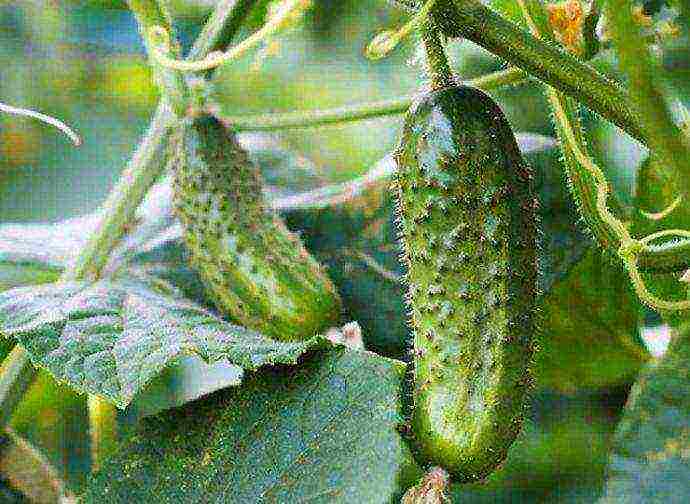
Self-pollinated variety that bears fruit well in greenhouses. The plant is indeterminate, slightly branched, with a predominance of female flowers in the node. Ripening of delicious salad fruits begins in 44 days. Productivity - up to 14 kg from 1 square meter of greenhouse.
Herman F1
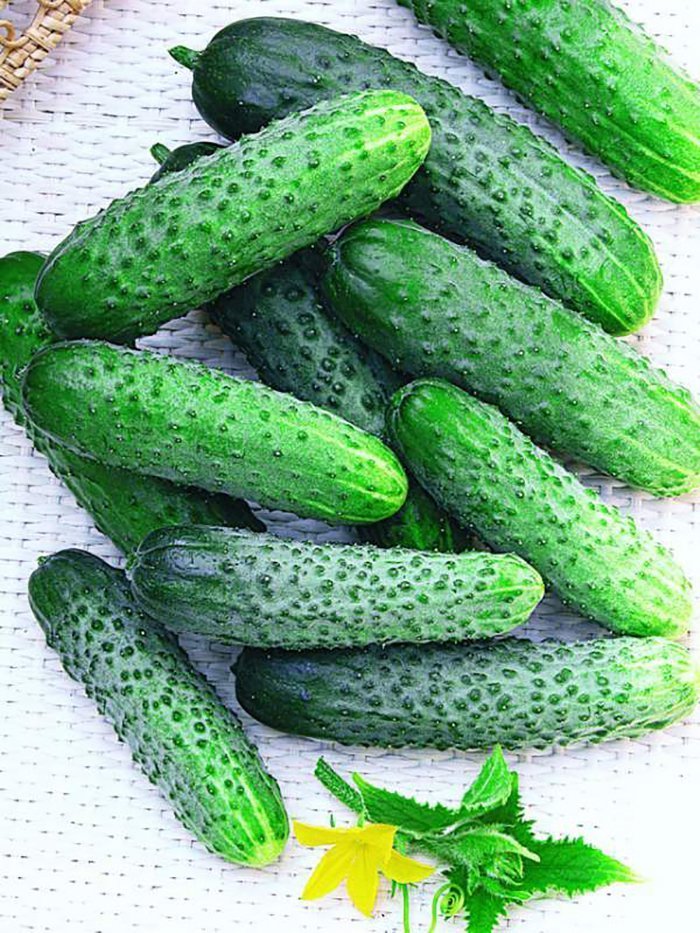
An early hybrid with long-term fruiting, high-yielding (9 kg per plant per season). With sufficient nutrition, a powerful plant simultaneously forms in one node up to 6-7 dense large-tuberous fruits of the gherkin type, genetically devoid of bitterness. Suitable for vertical and horizontal cultivation in greenhouses and outdoors.
F1 Director
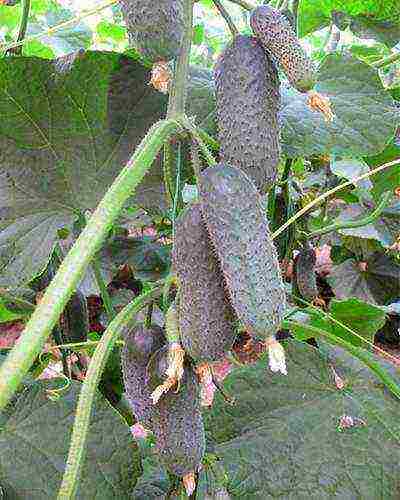
Parthenocarpic early ripening (43-45 days) cucumber hybrid with long fruiting and high shade tolerance. The plant is powerful, the root system is well developed. Fruits 9-10 cm long and weighing 65-80 g are dark green, large lumpy, cylindrical, genetically without bitterness, used for canning and fresh consumption. Productivity in a greenhouse - 18-20 kg per 1 sq.
Courage F1
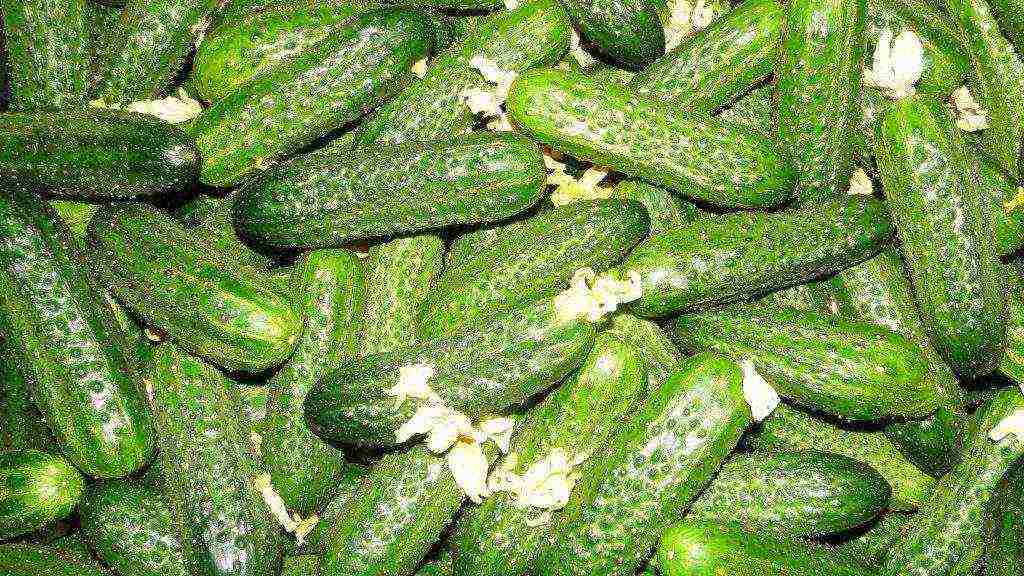
Early (45-50 days) hybrid of the female flowering type. A vigorous plant with medium shoot formation forms 2-4 ovaries in nodes. White-thorny, lumpy, dark green fruits with light stripes reach a length of 12-15 cm and a mass of 120-130 g.
Little Finger F1
Self-pollinated disease-resistant hybrid for spring unheated greenhouses, starts fruiting from the 46th day from germination. Fruits with good taste and firm pulp are ideal for salads and preparations. Productivity - 11.3 kg per 1 sq.
Goosebump F1
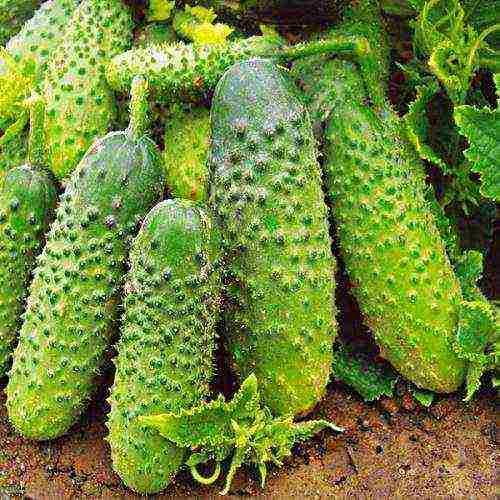
High-yielding early ripening parthenocarpic (42-45 days) universal cucumber variety with high taste. The plant is medium-sized, bunched flowering, with limited growth of lateral shoots. Large lumpy fruits 8-12 cm long are good fresh and for pickling. Bitterness in them is genetically absent.
Tom Thumb
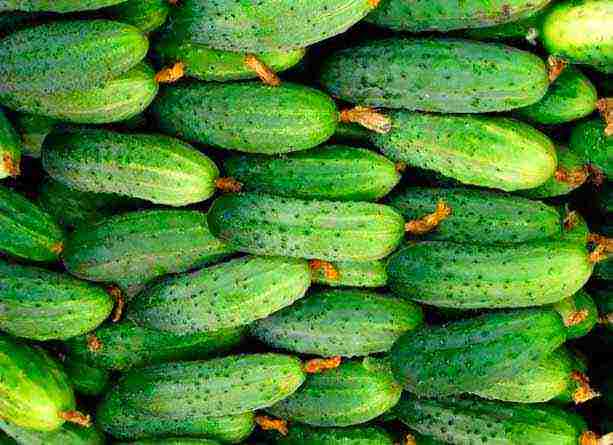
A disease-resistant, early-ripening cucumber variety for pickling and canning, begins to bear fruit already on the 39th day. Gherkin-type zelents grow in length no more than 11 cm with a mass of 50-65 g.
Benefit F1
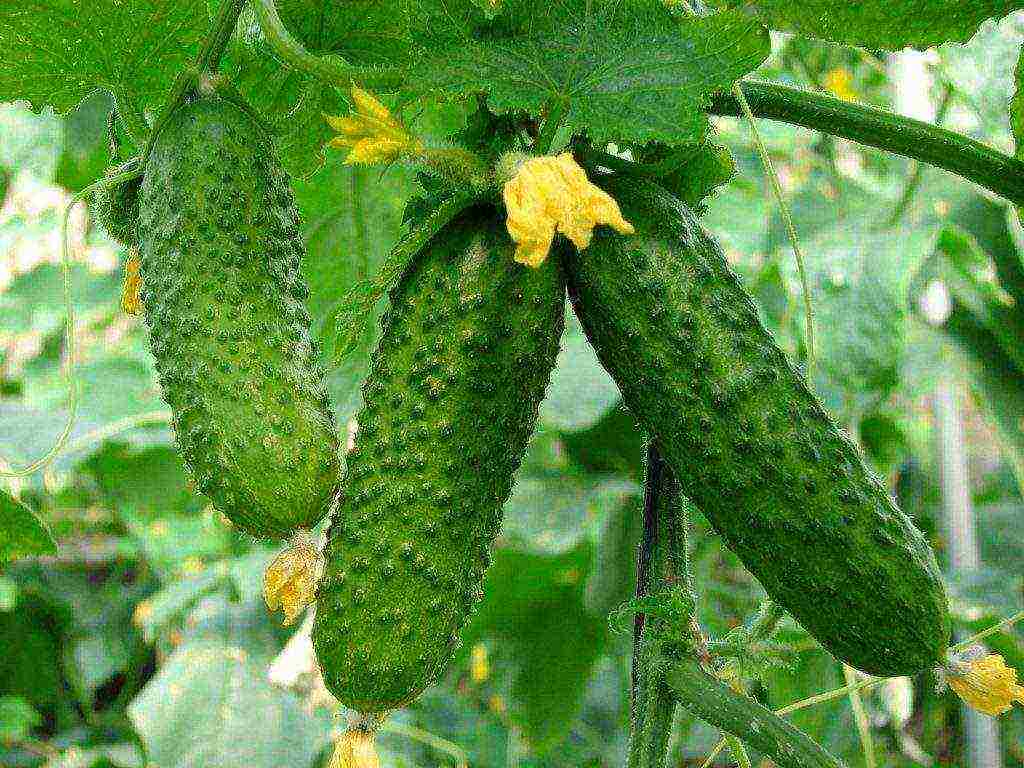
Self-pollinated early ripening (43-50 days) hybrid of a female cucumber flowering type. Densely covered with small tubercles zelents grow up to 10-12 cm in length with a mass of 100-120 g. Fruits for universal purposes (fresh consumption, pickling, salting) are distinguished by high taste and are devoid of bitterness.
Alekseich F1
Hybrid of female type of flowering, early maturing (37-43 days), parthenocarpic. A universal variety with slightly lumpy fruits 7-8 cm long and weighing 60-80 g has excellent taste.
Emelya F1
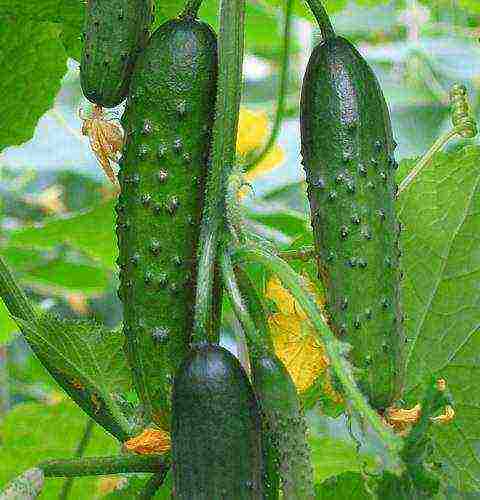
An early maturing parthenocarpic hybrid of universal purpose, it grows and develops better in heated greenhouses. Indeterminate (having unlimited growth of lashes), predominantly female flowering type, fruits ripen in 40-45 days.
Spino F1

Super early self-pollinated hybrid, forming many ovaries. Bouquet bloom, with a predominance of female flowers. The fruits are calibrated, 12-14 cm long, with excellent taste, do not taste bitter, are well stored and transported.
The best varieties for open ground
Varieties and hybrids intended for early salads, for which early maturity is important, are planted in open ground. For conservation, other varieties are planted, for which small sizes are much more important, amicable ripening of fruits, the pulp retaining its density during heat treatment.
Alligator F1

Long-term fruiting bee-pollinated early maturing (46-48 days) hybrid with excellent taste. The plant is vigorous, powerful. Elongated-cylindrical green fruits 35-40 cm long are juicy, aromatic, sweet, with a thin delicate skin, are recommended for fresh consumption and canning in cut slices. Productivity - 14-16 kg from 1 sq. M.
April F1
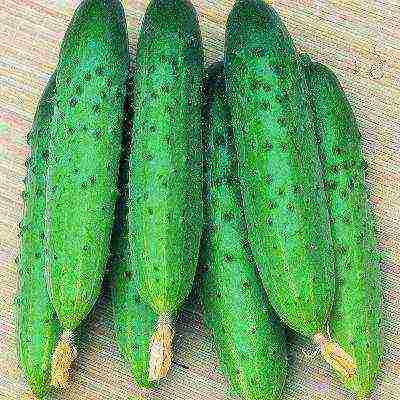
Universal early maturing (45-55 days) hybrid. Due to its compactness and ability to self-regulate branching, it is suitable for growing in the open field and in small boxes on the balcony. Fruits are cylindrical, large, reach a length of 22-25 cm with a weight of 200-250 g. The hybrid is undemanding to care for, relatively cold-resistant, fruitful, without bitterness.
Bouquet F1
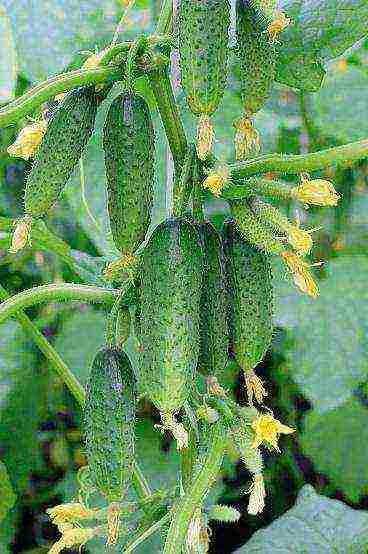
A universal hybrid, a weakly plaited plant, with unlimited growth and a predominance of female flowers. Bouquet-type flowering and fruiting: each node has 2 to 6 flowers. The fruits are short, elongated, covered with small tubercles. 5-7 kg of tasty greens weighing 90-100 g are collected from 1 square meter, which are used for salads and preservation.
Gourmet
An early ripening universal variety with a prolonged fruiting period, resistant to short-term cold snaps. The plant is long-leaved, powerful. Small lumpy aligned cylindrical cucumbers 9-12 cm long with delicate dark green skin, dense pulp with a high sugar content, small seed chamber. Productivity - 7 kg 1 sq. M.
Salting

Bee-pollinated early maturing (41-46 days) variety intended for open ground.The plant is medium-sized, long-leaved, with a mixed type of flowering. Elongated-cylindrical large-lumpy cucumbers of medium length (10-11 cm) weighing 100-125 g with black pubescence are recommended for pickling. The yield is stable - 3.5-5 kg per 1 square meter.
Emerald Stream F1
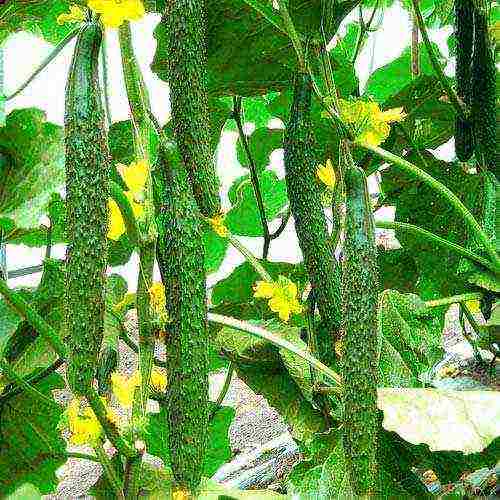
Cold-resistant shade-tolerant early maturing (44-48 days) parthenocarpic hybrid with a continuous long period of fruiting. The plant is weakly plaited, vigorous. Elongated cylindrical dark green lumpy cucumbers 30-50 cm long and weighing 150-200 g with a thin delicate skin have an excellent aroma and taste, perfect for salads. Productivity - about 6 kg from 1 sq. M.
Elegant
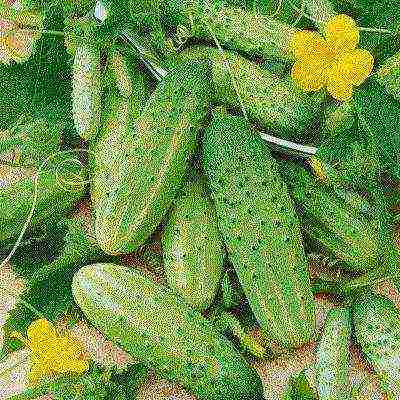
Cold-resistant bee-pollinated early maturing (40-50 days) medium-growing variety of cucumbers for open ground, resistant to olive spot. Small-tuberous white-thorn greens weighing about 140 g reach 10-13 cm in length. Eaten fresh, great for pickling and pickling. Productivity - 5-7 kg from 1 sq. M.
Ira F1
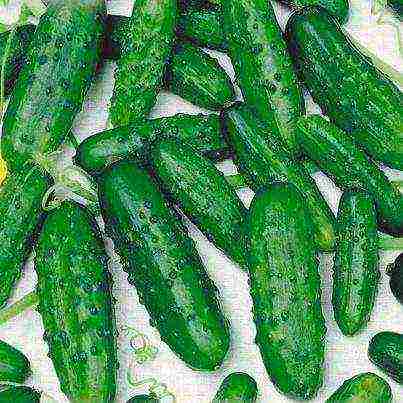
Characterized by stable high yields (9.5-10.2 kg per 1 sq. M) bee-pollinated ultra-early (45-50 days) hybrid. Medium-growing plant forms 2-3 ovaries in one node. Cylindrical large-tuberous dark green fruits 12-15 centimeters long and weighing 55-85 g with dense crunchy pulp have excellent taste.
Karelian F1

Early maturing (43-45 days) short-fruited self-pollinated high-yielding cucumber. Large-lumped fusiform cucumbers 8-10 cm long with high taste and marketability are intended for pickling. The hybrid is cold-resistant, with a prolonged fruiting period and the simultaneous filling of several ovaries.
Corinna F1
High-yielding (5.2-6 kg per 1 square meter) ultra-early ripening parthenocarpic hybrid of German selection. The plant is medium-sized, the yield of fruits is friendly. Dark green gherkins 8-10 cm long without bitterness, white thorns, small tubercles, with excellent consistency, remain crispy and dense when preserved and salted.
Ant F1
Ultra-early ripening (35-39 days) cucumber with large-lumpy cylindrical fruits up to 12 cm long. The plant is of bunch-type flowering, medium-growing, branching of lateral shoots is limited.
Masha F1

Resistant to unfavorable growing conditions, high-yielding ultra-early ripening (35-39 days) parthenocarpic hybrid with high-tasting large-tuberous fruits of the gherkin type of regular cylindrical shape, genetically devoid of bitterness.
Nezhinsky 12

An unpretentious mid-season bee-pollinated variety of cucumbers, one of the best for pickling. Large-tuberous black-spiked short fruits weighing 80-110 g with crispy pulp and excellent taste, elongated-ovoid, reach 10-12 cm in length. The variety is resistant to bacteriosis and olive spot. Productivity - 1.5-2 kg per square meter.
Competitor

A cucumber with good taste is an early ripening (43-53 days) fruitful pickling variety with elongated-oval fruits completely covered with large tubercles, up to 12 cm long (weight about 120 g). The variety is highly resistant to disease.
Connie F1
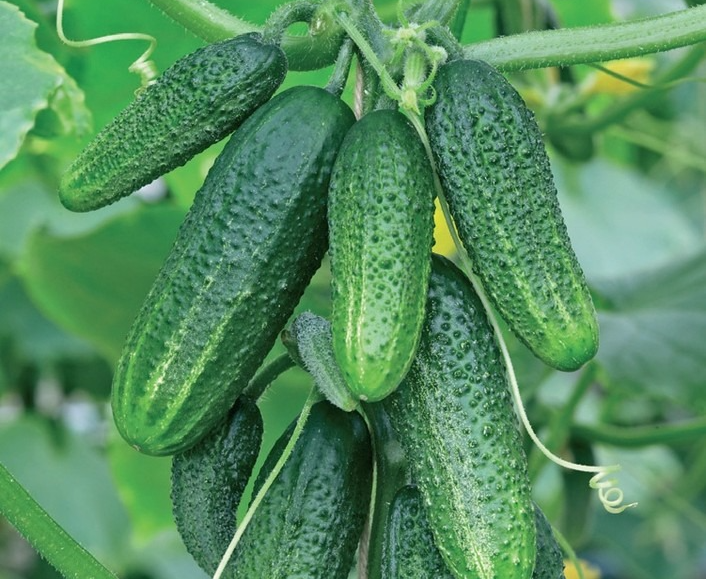
An early (43-45 days) resistant to overgrowth cucumber hybrid of the gherkin type, parthenocarpic, high-yielding (14-16 kg of fruits per 1 square meter). The plant is medium-growing, the formation of ovaries is bundle. Short bright green small-tuberous white-thorn fruits have excellent taste: juicy, crunchy, without bitterness.
Spring F1

A bee-pollinated mid-season (48-55 days) cucumber with cylindrical fruits covered with small tubercles with sparse thorns, without bitterness, suitable for canning and pickling. A ripe cucumber weighing no more than 100 g reaches a length of 12 cm.
Miranda F1
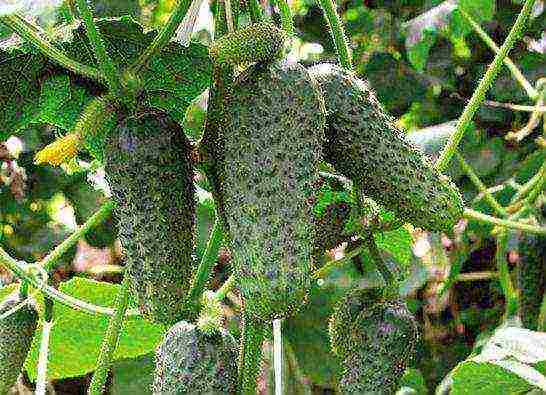
Cucumber with increased cold resistance and disease resistance, high-yielding (6.3 kg per 1 sq. M) early-maturing universal hybrid.A well-leafy, vigorous plant with fragrant juicy fruits of green color with white specks, which are suitable for salads and any processing, especially pickling.
Son of the F1 Regiment
Medium early (40-45 days) bee-pollinated cucumber with long, abundant fruiting. Cucumbers are oval, white-spiked, do not turn yellow or outgrow. High technological, commercial and taste qualities. Suitable for processing gherkins and pickles. Productivity - 3.6-4.5 kg per 1 sq.
Cucumber varieties for shady areas
If there is no sunny place left at the summer cottage, you can plant cucumbers in partial shade. It is in such conditions that some varieties grow well:
Everyone is the envy of F1

A high-yielding, early-maturing gherkin hybrid, even with a lack of light, is comprehensively resistant to bad weather and diseases. Fruiting before frost, more than 3 ovaries are formed in each node. Dense crunchy fruits 9-12 cm long are covered with white thorns and have excellent salting qualities.
Chinese disease resistant F1

Highly productive, tolerant to low light and cold, medium early (48-54 days) hybrid of excellent quality. A powerful plant that forms into one stem. Dark green even cylindrical fruits 30-35 cm long with a large lumpy shiny surface are recommended for making salads, pickling, and canning.
Muromsky 36
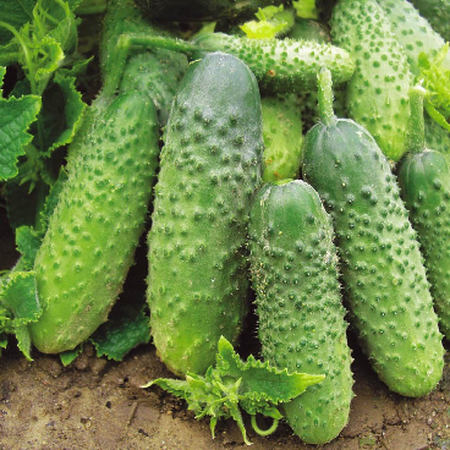
Resistant to short-term temperature drop, early ripening (35-45 days) pickling variety with smooth or small-tuberous light green fruits of ovoid or ellipsoidal shape, reaching a length of 6-8 cm. Fruits need to be harvested often, as they quickly turn yellow.
F1's secret
An early maturing (38-42 days) parthenocarpic hybrid, resistant to powdery mildew and cladosporium, for universal use. The plant is medium-branched, with a female flowering type. A medium-sized, slightly ribbed, cylindrical green plant weighs up to 115 g.
Moscow evenings F1
Mid-season (42-45 days) parthenocarpic hybrid of cucumber. Fruits with excellent taste are suitable for fresh consumption and salting. The plant is strongly plaited, mainly of the female flowering type. Lumpy cylindrical fruits of dark green color reach a length of 14 cm, weight does not exceed 110 g.
The best varieties of cucumbers for the balcony
You can also arrange a cucumber "bed" on the balcony. The main thing is to choose the right variety:
Swallowtail F1

Parthenocarpic early ripening gherkin hybrid, type of flowering is predominantly female. Small (up to 11 cm) spindle-shaped greens weighing 60-110 g have high taste and pickling properties.
Hummingbird F1
Gherkin parthenocarpic hybrid with small branching, early maturing, intended for cultivation in the spring-summer period on loggias, balconies, verandas. Short lumpy white thorny greens 5-8 cm long and weighing 60-80 g have excellent taste.
Balcony F1
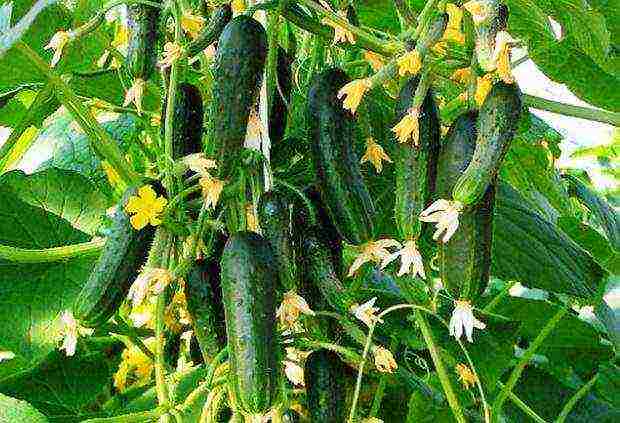
Tufted gherkin with medium branching, forming from 2 to 6 ovaries sequentially poured into the node. Zelentsy 6-10 cm long, white-spiked, lumpy, do not outgrow for a long time.
Garland F1
Early ripening (45 days) bundle gherkin for universal use. Fruits 12-14 cm long, without bitterness, disease resistant.
Tomboy F1
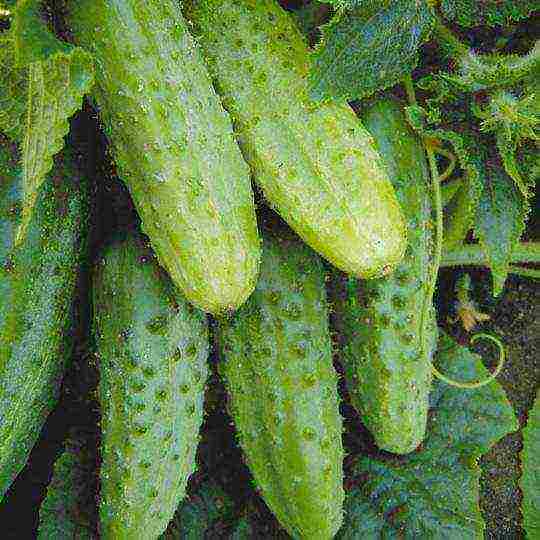
Sheaf gherkin cucumber, bearing fruit in 43-48 days. In each node, 8-10 ovaries are formed. Dark green medium-lumpy cucumbers 10-12 cm long and weighing 90-100 g have an excellent taste.
When choosing varieties of cucumbers for growing in greenhouses and greenhouses, you need to pay attention to several parameters. All of them have an impact on the final result - the harvest. Below we will consider the features of selection, and also give the best varieties of cucumbers for greenhouses for 2017-2018, according to gardeners' reviews.
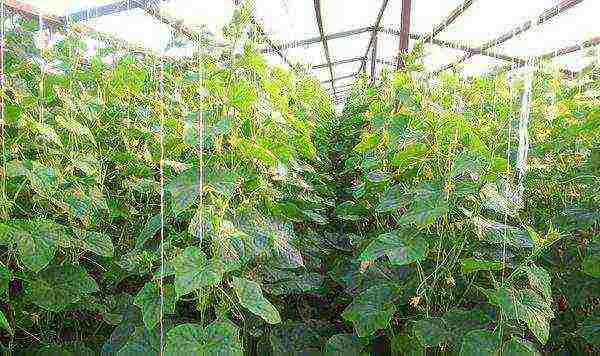
Indoors, 3 groups of modern varieties can develop normally:
- Hybrids with 100% parthenocarp (fully self-pollinated) are the most successful option.
- Hybrids of the female type of flowering (with a predominance of female flowers) are more suitable for semi-open greenhouses; it is advisable to plant several bushes with male flowers to them (for better pollination).
- Chinese variety - hybrid and varietal (non-hybrid) forms. They tolerate temperature contrasts very well. Appointment - mainly salad.
Is it possible to plant different varieties of cucumbers in one greenhouse? Experienced vegetable growers answer this question in the affirmative. It is not recommended to give preference to only one variety, for reliability it is better to plant at least 2-3, from different companies.
Benefits of hybrid greenhouse cucumbers
Selection factors for specific varieties:
- We purchase seeds only from the most reliable companies.
- Almost all modern hybrids do not taste bitter, and this feature is not always mentioned on labels now, this is implied by itself. Bitterness can appear in old varieties or in vegetables from unscrupulous producers.
- Pay attention to the timing of the return of the crop: fast and friendly or extended.
- We calculate in advance the required amount of salad and gherkins.
- The degree of bumpiness ("shirt") is a matter of personal taste. Breeders offer many different options.
- If it is not possible to pay much attention to planting, cucumbers with restrained lateral branching that do not require shaping will help out (these also exist now).
- There are special hybrids for shaded areas.
- Preference should be given to forms with maximum resistance to various infections.
It should be remembered that modern breeding has achieved tremendous success in the field of disease resistance of cucumbers, but they are still susceptible to attacks by insect pests (greenhouse whitefly, spider mites, melon aphids, etc.).
Review of the best varieties of cucumbers for greenhouses for 2017-2018

For polycarbonate greenhouses
Polycarbonate greenhouse cucumber varieties are selected with the longest fruiting period and maximum tolerance to pathogens.
Herman F1
One of the most popular cucumber hybrids (beware of fakes!). Dutch selection. Stable and reliable. It bears fruit perfectly in any greenhouses and in the open air. Not afraid of heat, cold snap and disease. One of the first to bear fruit and one of the last to finish.
Bunch ovary (up to 7 pcs.), With simultaneous filling of several fruits in different nodes. Cucumbers are lumpy, strong, medium-sized, high quality, excellent presentation.
Maryina Roshcha F1
Selection of the Russian company "Manul" (Timiryazev Academy). An early hybrid with a long period of fruit formation.
It is not affected by dangerous diseases, including root rot and downy mildew.
Parthenocarp is very pronounced, the ovaries grow actively in any conditions (extreme temperatures, lack of sunlight). One node contains up to 5 pieces. At the same time, more than a dozen zelents can be poured on the bush - large-lumpy, 11 cm in size.
Masha F1
A very early Dutch hybrid with massive early recoil. Moderate branching, the bushes do not thicken. Disease resistance is good. Zelentsy 8 cm, dark, with rather sparse tubercles.
Pace F1
Early ripening (37-42 days) gherkin from the Semko firm. Does not suffer from peronosporosis and other destructive diseases. Light-loving, slightly branched. In a knot there are up to 5 ovaries. Pickle output - 10 kg / sq. m., gherkins - more than 20 kg. The density of the pulp is the highest, the seeds are not felt.
Shchedryk F1
A hybrid from the Russian company "Gavrish" with the entry into fruiting on the 45th day. Tolerant to root rot, peronosporosis. There are 5-8 ovaries in a knot. Cucumbers grow up to 10 cm; the tubercles are large, white-spined. Recoil from a bush - more than 6 kg.
Many vegetable growers prefer to grow this heat-loving vegetable in carbonate greenhouses, where the optimum temperature and humidity are created. The only serious problem is the risk of the rapid spread of harmful insects. You have to be on the lookout all the time.
For foil greenhouses and greenhouses
The best varieties of cucumbers for a greenhouse that is covered with a film must be resistant to sudden temperature changes. It is advisable to select vegetables for greenhouses with genetic resistance to root rot.
In low greenhouses, short-stemmed (bush) forms are convenient.
Adam F1
Mid-early (45 days) Dutch hybrid of the new generation. It is not affected by peronosporosis and other pathogens. The recoil is long-term, uninterrupted. Cucumbers no more than 95 g, very strong; surface with small tubercles. The appointment is universal.
Courage F1
Selection of the Russian company "Gavrish". Fruiting begins one and a half months after germination. The bush is powerful, with a bundle ovary (2-6 pieces), the load of the crop is more than 7 kg. Lumpy cucumbers, size 120 g. Disease resistance - complex.
Okhotny Ryad F1
Super early parthenocarpic from the Manul firm, resistant to peronosporosis and other diseases. Restrained branching. Cucumbers are sparsely lumpy, 8 cm in size. Tufted ovary - up to 6 pieces.
According to my desire F1
Mid-season hybrid of the St. Petersburg company "Biotekhnika" from a series of so-called "single-stem" - with extremely short lateral branches. Does not require shaping. Tolerant to shading, cold snaps. There are 3-4 ovaries in the knot. Zelentsy are sparsely lumpy, crispy.
Miracle toddler F1
A novelty presented by the "Aelita" company. Plants enter fruiting early (38 days from the beginning of the growing season), are distinguished by powerful growth and long-term growth of bundle ovaries. White-thorn cucumbers, 80 g in size, with large tubercles. Productivity - up to 15 kg / sq. m.
Gardeners note that many modern cucumber hybrids grow well even in the simplest, uncomplicated greenhouses. Plants withstand any whims of bad weather with honor.
For autumn-winter cultivation
Special hybrid varieties for the winter greenhouse are resistant to lack of sunlight. Zelentsy are growing large, their purpose is salad.
F1 Olympics
Mid-season hybrid selection "Manul" for winter greenhouses. Long-term yield on lateral shoots: yield reaches 45 kg per sq. meters. Demonstrates high adaptability. The root system is not subject to decay. Fruits are 18 cm in size, lumpy, white-thorn.
Offers from the company "Semko"
- Ararat F1... A smooth-fruited hybrid with green plants weighing up to 150 g. Plants show resistance to downy mildew and stress. Recoil - up to 250 kg from 10 sq. m.
- Sapsho F1... A mid-season hybrid that begins to bear fruit 2 months after germination. In each node, 1-3 fruits 15 cm in size are formed, with medium-sized tubercles. The output of marketable vegetables per square meter is more than 20 kg.
- Tatiana F1... The cucumber is mid-season, long-leaved .. The size of the green is 17 cm, 140 g. The tubercles are spiny. General collection from 10 sq. m - 240 kg and more.
Self-pollinated (parthenocarpic)
Almost all modern varieties of greenhouse cucumbers are self-pollinated. They produce only female flowers, and their ovaries grow to the size of green plants even without the access of pollinating insects.
In this case, full-value seeds are not formed.
Heroic Strength F1
Selection of the agricultural firm "Manul". Very early gherkin, with complex infection resistance. Long-term yield on lateral branches. There are 8 or more ovaries in a knot. Cucumbers are lumpy, pubescent, 8 cm in size.
Son-in-law F1
Popular parthenocarpic from the Gavrish company. Comes into fruiting one and a half months after germination. At the nodes, from 2 to 8 zelents 10 cm in size are formed (can be collected at the stage of pickles and gherkins).
Valuable quality - resistance to downy mildew and powdery mildew, root rot, weather stress. One bush gives up to 7 kg of products.
Claudine F1
An early maturing Dutch hybrid with high quality small tuberous greens. Fruit weight - up to 85 g. Bushes are medium-sized, disease-resistant, fruitful.
Blizzard F1
Early ripening parthenocarpic from Biotekhnika. The lateral branches are short.Fruits are small - 65 g, 7 cm. In one node - 3-4 ovaries. The hybrid withstands waterlogging in the root zone, does not get sick with real and downy mildew.
Prestige F1
Popular gherkin of the Zedek selection. Resistant to diseases, temperature stress, shading. Entry into fruiting - from 42 days. The fruits are pimply, neat, dense, no more than 8 cm in size. The yield is long, at the end of the season - up to 25 kg per square meter.
Early
Early varieties of cucumbers are divided into two categories - with "hurricane" fruiting (rapid, massive formation of the crop) and long-term gradual return.
Blizzard F1
A very early (from 37 days) hybrid from the St. Petersburg firm "Biotekhnika". Not susceptible to damage by downy mildew and powdery mildew. Lateral branching is restrained. There is a simultaneous pouring of more than a dozen fruits; their size is 7 cm.
Maresa F1
Novelty of the Dutch selection; comes into fruiting 38 days after germination. High yield and disease resistance. Cucumbers are small, leveled, of excellent presentation.
Masha F1
Very early (from 36 days) gherkin from Holland with amicable return early. Cucumbers are very dense, 8 cm long, even, dark. Excellent resistance to pathogens, consistent harvest every summer.
Meringue F1
A high-yielding Dutch hybrid with uniform marketable cucumbers. Zelentsy are large tuberous, dense. Fruiting begins 37 days after the beginning of the growing season.
Uranus F1
Ultra-early (36 days) novelty from the Japanese corporation Sakata. The plant is cold-resistant and heat-resistant. Cucumbers of uniform green color, weighing 90 g. Salting qualities are very high.
According to the reviews of most gardeners, early ripening varieties are considered the most attractive.
However, not everyone likes that by the end of the season they have already completed fruiting. That is why it is necessary to give space to mid-late cucumbers. And recently, early maturing hybrids with a very long yield have appeared.
Beam varieties
The varieties of bunch cucumbers are very productive, but they have high nutritional requirements, and some also have bright lighting.
Friendly family F1
Popular gherkin from the Gavrish company. The yield of the crop begins one and a half months after germination. In the nodes of the lateral branches, 7-8 ovaries are laid. The recoil is massive, the disease resistance is at the highest level.
Square dance F1
Early parthenocarpic from the Gavrish firm. The ovary on the main stem is of a bouquet type (up to 10 per node). The fruits weigh 90 g each, they are strong, with large tubercles. The bushes are resistant to cold snaps, do not get sick with downy mildew and powdery mildew.
The output from one plant is more than 6 kg.
Magdalena F1
Dutch novelty for the production of pickles and gherkins with the highest pulp density. The color is saturated. In the nodes, 7 zelents are poured. The hybrid successfully resists attacks from pathogens and temperature stresses.
Beam Charm F1
The newest Russian hybrid from the Aelita company. A bouquet ovary can produce 10-12 tuberous greens.
Miracle bouquet F1
Harvesting novelty of the selection "Gavrish". At the same time, more than three dozen fruits grow on the bush, in bunches of 3-5 pieces. The age of entry into fruiting is from 42 days. Disease resistance - up to date. The yield is long lasting.
Amateur vegetable growers note that the potential of superbeam hybrids is successfully realized only with abundant feeding and good water supply.
Cucumber varieties for greenhouses according to various characteristics
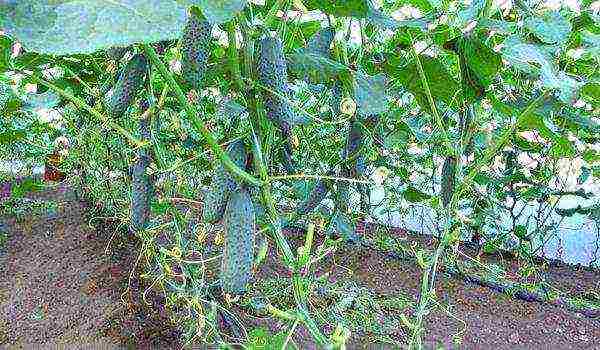
The most productive
The most productive varieties of cucumbers for a greenhouse combine several valuable features: early maturity and a long fruiting period, bundle ovary and genetic resistance to infections.
- Herman F1
- Courage F1
- Marinda F1
- Prestige F1
- Pace F1
- Ecole F1
Sustainable
High resistance to disease and weather stress is an essential requirement for modern cucumber culture.The labor and financial costs for chemicals are reduced, the yield and ecological cleanliness of vegetable products are increased, and the pesticide load on the environment is minimized.
- Barvina F1
- Stay healthy F1
- Great Caesar F1
- Kyoto King F1
- Trump F1
- Focus F1
- Eskimo F1
For pickling and canning
For canning (blanks with vinegar), any cucumbers with dense pulp and small seeds are suitable. It is desirable that they are not prone to rapid overgrowth and thickening ("paunchy").
In the classic (old) version of pickling without vinegar, black-spiked cucumbers are considered the most suitable (the choice of such hybrids, unfortunately, is limited).
- Spring F1
- Crocodile F1
- Goosebump F1
- Robin Hood F1
- Mother-in-law F1
Gherkins
Gherkin varieties are a special breeding line. For the production of pickles and gherkins, special hybrids have been bred.
- Baby Mini F1
- Sankin love F1
- Son of the F1 Regiment
- Pace F1
- Ecole F1
Varieties by origin
Dutch varieties
Holland is the world leader in hybrid cucumber breeding. Particular attention is paid to the complex resistance to infections. The assortment is designed for every taste. As a rule, Dutch cucumbers have a strong (even tough) rind.
Varieties: Claudine F1 (updated Claudia F1), Madita F1, Mila F1, Monisia F1, Cartridge F1
German varieties
The classic "German shirt" is a finely bumpy surface of the fruit. Such cucumbers have an excellent presentation and are good for pickling. Popular old hybrids (Libelle F1, Moringa F1, Ira F1, Rita F1) are bee-pollinated.
Germanic parthenocarpics may be more or less spiny, but they still show high quality zelents.
Varieties: Harmony F1, Ginga F1, Dirigent F1.
Chinese varieties
Chinese long-fruited cucumbers are a special variety. It is attracted by the excellent taste of salad orientation - thin skin, fragrant pulp. Pleases with excellent, stable yield and a high degree of adaptability to various weather conditions.
Varieties: Serpent Tempter F1, Emerald Stream F1, Chinese Gin F1, Chinese Serpent (not hybrid), Beijing Delicious F1.
Cucumber varieties for regions
For the Middle Lane: Walk, Russia! F1, Paratunka F1, Russian motives F1, Russian style F1, Russian feast F1.
For Moscow region: Arbat F1, Connie F1, Moscow delicacy F1, Moscow salad F1, Moscow evenings F1.
For the Leningrad region: Bimbo-Star F1, Joulupukki F1, Karelian cones F1, Lapland F1, St. Petersburg Express F1.
For Siberia: Ob Emeralds F1, Nord Stream F1, Siberian Bouquet F1, Siberian Walker F1, Siberian Express F1.
For the Urals: Everyone envy F1, Our granddaughter F1, RMT F1, Uralochka F1, Uralskiy gherkin F1.
Reviews of gardeners about cucumbers for greenhouses for 2017-2018
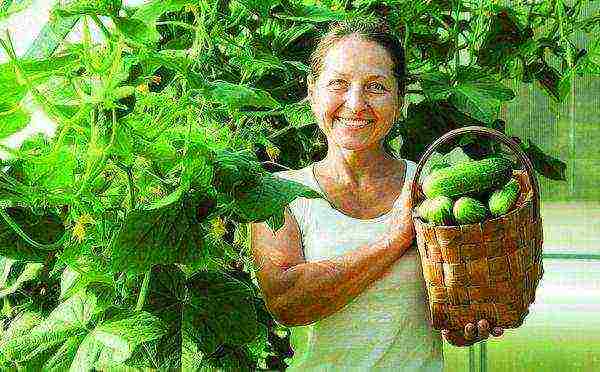
For cultivation in a greenhouse, it is recommended to choose parthenocarpic (in which fruit ovaries pass without pollination) or self-pollinated cucumber varieties.
This will allow you not to worry about attracting bees to the greenhouse by additional replanting of flower plants or spraying cucumbers with infusions of honey or jam.
According to their purpose, cultivated cucumbers can be divided into:
- salad;
- salting;
- universal.
We will define in each of these categories the varieties that received the best reviews from specialists and gardeners in 2017.
The best salad varieties
Cucumbers intended for fresh consumption should be slightly sweet in taste, without bitterness, tender and crunchy. According to many reviews, the following hybrid varieties have such qualities:
- Courage F1;
- Martha F1;
- Tsarsky F1;
- Orlik F1.
"Yielding, very tasty cucumbers", "Do not get sick, all summer with cucumbers" - typical statements about these varieties.
The best varieties for pickling
For pickling, cucumbers with a dense consistency, small sizes and with a skin that does not prevent the penetration of salt into the fruit are better suited. According to reviews, the following varieties and hybrids fully meet these requirements:
- Vyaznikovsky;
- Altai;
- Great F1;
- Moscow dude F1.
“Beautiful, even fruits”, “Pickled cucumbers turned out to be firm and crispy, very tasty” - these are the impressions consumers share about these varieties.
The best universal varieties
Cucumbers of these varieties should be good to eat both fresh and after heat treatment (canning). Many good reviews received such varieties as:
- Finger boy F1;
- Moravian gherkin F1;
- Northerner;
- Blessed F1.
The list of these wonderful varieties is far from being exhausted. In each of the categories of cucumbers (salad, pickling, universal) there are other good varieties that are in no way inferior to those listed.
Additional recommendations for choosing a variety of cucumbers for greenhouses
For cultivation in a greenhouse, it is better to opt for hybrids (often also called hybrid varieties). Their main advantage over traditional varieties is that they are resistant to all types of diseases.
This is especially important for greenhouses, in which greenhouse (sorry for the tautology) conditions are created not only for the cultivated crop, but also for various fungal diseases and pathogenic bacteria.
This stability, coupled with high yields and ease of maintenance, fully compensates for the increased costs of seeds. To distinguish a hybrid variety from a regular variety, seed producers add the combination F1 after its name.
Good harvests to you!
Seemingly in cultivation
cucumbers
there is nothing difficult. And this is true, but only if you approach the matter with a certain amount of knowledge. Including about
varieties which are best suited for growing in your area.
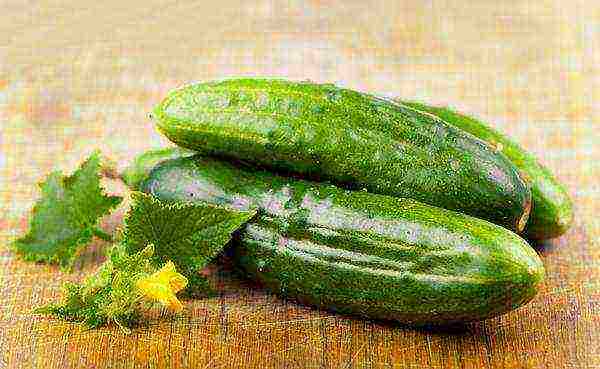
The variety of cucumbers matters. How to navigate in general in the abundance of cucumber varieties and choose the ones you need is described in detail and sequentially in the article Choosing varieties of cucumbers. Let me briefly recall the main points.
First of all, you need to answer yourself for 3 questions:
- Where do you intend to grow cucumbers: in a greenhouse, a greenhouse, in the open field or even on a windowsill?
- When do you want to harvest: early June, July or August?
- How long do you want to harvest cucumbers?
So, early varieties of cucumbers more susceptible to diseases, and the term of their fruiting, in comparison with the later ones, is much shorter. And, despite the fact that the division of cucumbers into early, medium and late is somewhat arbitrary, the choice of the variety will depend on the answers to these 3 questions.
Only correctly selected varieties are not so scary disease, which most often affect cucumbers in the middle zone: powdery mildew, downy mildew and bacteriosis, therefore, when choosing a variety, you should pay special attention to itsresistance to these diseases... To cope with the misfortune will help the article "Ambulance" for cucumbers: prevention and treatment of diseases.
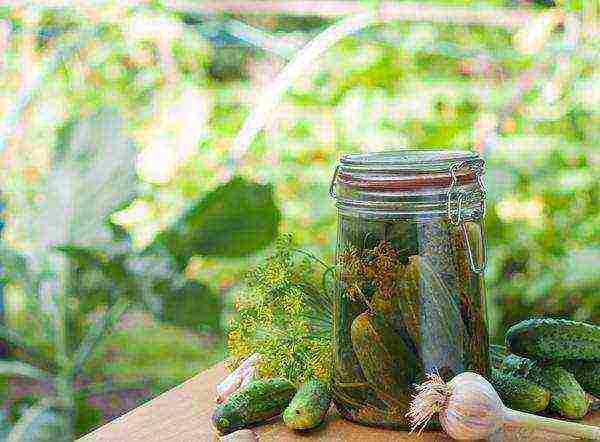
Not every variety of cucumbers is suitable for pickling.
Another question: what exactly do you need cucumbers for - for eating fresh or for pickling? Their varieties are conventionally divided into 3 groups according to their purpose: pickling, salad, universal... Naturally, each of the varieties has its own advantages, but everyone should choose the optimal one for himself, depending on his needs and desires. For example, I always plant half of the pickling varieties and 25% each of the salad and universal varieties.
By the way, the secrets of cultivation have already been discussed in this article, and it can also be useful when choosing varieties.
Well, we are with you, having finished with the theory, we will move on to the descriptions of the most popular varieties of cucumber in the middle lane for greenhouses, open ground, shady areas and a home garden.
The best varieties of cucumbers for greenhouses and greenhouses
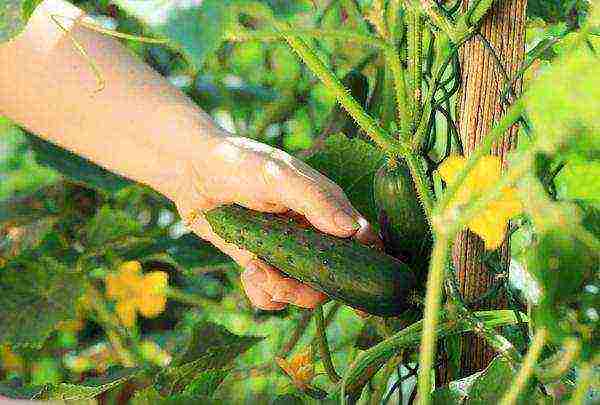
Parthenocarpic varieties and hybrids are preferred for greenhouses
'Goosebump F1'
An early maturing (from 42 to 45 days after sowing) parthenocarpic (that is, self-fertile, not requiring pollination) high-yielding hybrid produced by the Gavrish agricultural company (our review tells more about this and other seed producers). Bunch-type plant of flowering, medium-sized; the growth of side shoots is limited. Fruits are large lumpy with small black thorns up to 8–12 cm long; bitterness is genetically absent in them. Variety distinguished by high taste, versatility: good both fresh and for salting. Very resistant to powdery mildew and downy mildew; suitable for growing in greenhouses, hotbeds, as well as in the open field.
'Tom Thumb'
An early ripening (fruiting already on the 39th day) variety with a female flowering type, characterized by resistance to a whole range of diseases. Zelentsy, growing no more than 11 cm in length and weighing 50–65 g, will be appreciated by lovers of gherkins. The fruits are great for canning and pickling.
‘Benefit F1’
Early ripening (43-50 days from germination to fruiting) self-pollinated hybrid of the female flowering type. Zelenets weighing up to 100-120 g and 10-12 cm long is densely covered with small tubercles. Fruit are devoid of bitterness and are distinguished by high taste, universal (salting, pickling, fresh consumption). The hybrid is very resistant to real and downy mildew and root rot.
‘Alekseich F1’
Early maturing (from germination to fruiting - 37-43 days) parthenocarpic hybrid of the female flowering type. The plant is medium-sized, a universal variety, fruits are slightly lumpy, weighing 60-80 g and 7-8 cm long, green plants have excellent taste... The hybrid is extremely resistant to powdery mildew as well as downy mildew.
'Emelya F1'
A universal early maturing parthenocarpic hybrid, the fruits of which are successfully used both fresh and for salting. It grows and develops better in heated greenhouses. The fruits ripen quickly - in 40-45 days. The bush is indeterminate (has unlimited growth of lashes), with a predominantly female type of flowering and bundled ovaries.
The general principles that should be followed when choosing "greenhouse" cucumbers are set out in the article How to choose varieties of cucumbers for greenhouses.
The best varieties of cucumbers for open ground

Varieties for open ground are selected especially carefully.
‘April F1’
An early ripening universal hybrid, the fruiting of which occurs 45-55 days after germination. It can be successfully grown not only in the open field, but also in small balcony boxes - the plant is compact and has the ability to self-regulate branching. The cylindrical fruits are rather large: with a weight of 200-250 g in length, they reach 22-25 cm. variety advantages: lack of bitterness, undemanding care and relative cold resistance, which makes it possible to get good yields in the open field.
‘Erofey’
Bee-pollinated mid-season universal (suitable both for fresh consumption and for canning) variety. Mixed flowering plant, highly branched and vigorous. Zelenets is short (about 6-7 cm), elongated-ovate, slightly lumpy. The variety is quite resistant to downy mildew.
'Ant F1'
Parthenocarpic ultra-early (35–39 days) hybrid. The plant is medium-growing, bunch-type flowering with limited branching of lateral shoots. The fruits are large-lumpy, cylindrical in shape, up to 12 cm long. The variety is resistant to olive spot, as well as to downy mildew and powdery mildew.
'Masha F1'
Parthenocarpic ultra-early ripening (35–39 days) high-yielding hybrid of beam flowering type with a long fruiting period. Fruits - large-tuberous gherkins of regular cylindrical shape - genetically devoid of bitterness, have the highest taste properties and are suitable not only for fresh consumption, but also for canning. The variety is resistant to a complex of diseases: powdery and downy mildew, cucumber mosaic virus and others, as well as to unfavorable growing conditions.
'Competitor'
Yielding early ripening (43-53 days) pickling variety with good taste. Fruits are elongated-oval or cylindrical, up to 12 cm long, completely covered with large tubercles, reaching a weight of 120 g. The variety is resistant to powdery mildew and bacterial spotting.
'Spring F1'
Mid-season (from 48 to 55 days) bee-pollinated hybrid, resistant to a complex of diseases. Cylindrical fruits, covered with small tubercles with sparse thorns, are devoid of bitterness; used for salting and canning. The length of a ripe green plant reaches 12 cm, and its weight does not exceed 100 g.
As the practice of our gardeners has shown, such varieties of cucumbers as ‘Far Eastern' and 'Phoenix', read more about the experience of growing which you can here in this post.
The best cucumber varieties for shady areas
Agree, the summer cottage is not equally illuminated from all sides by the sun, to which many garden crops are very demanding, and its area is not infinite. Tomatoes, peppers, eggplants - they all grow well only in open sunny areas, and sometimes there is simply no room left for planting cucumbers.
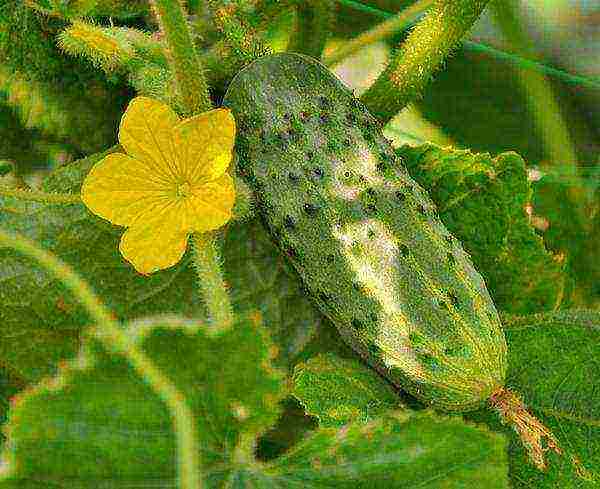
There are varieties of cucumbers that can grow even in partial shade But not everything is so hopeless, and if there is no longer an open sunny place on your site, it does not matter - feel free to plant cucumbers in partial shade, because there are varieties that grow well in such conditions.
‘Muromsky 36’
An early ripening (35-45 days) pickling variety, small-tuberous or smooth fruits of which reach 6-8 cm in length. Comparatively resistant to short-term drops in temperature... The fruits are light green, have an ovoid or ellipsoidal shape, and reach 6-10 cm in length. The peculiarity of the variety is that its fruits turn yellow quickly enough, so they need to be harvested often.
‘The secret of the F1’
Parthenocarpic early maturing (38-42 days) hybrid universal purpose... The plant is medium-branched, with a female flowering type. Zelenets cylindrical, slightly ribbed, medium-sized, weighing up to 115 g. The variety is resistant to powdery mildew, cladosporium blight.
'F1 Nights outside Moscow'
Parthenocarpic mid-season (42-45 days) hybrid, the fruits of which have excellent taste and are suitable for both salting and fresh consumption. The plant is predominantly female flowering type, strongly plaited. The fruit is cylindrical, lumpy, dark green in color with white pubescence. Its length reaches 14 cm, and its weight does not exceed 110 g. The variety is resistant to cucumber mosaic virus, powdery mildew, cladosporium disease.
Most of the varieties and hybrids listed in this article can be found in our catalog. A separate product selection is devoted to the best varieties and hybrids for the middle lane. Compare offers from different online stores and choose the most interesting and profitable ones!
Cucumber Muromsky 36 "Successful seeds" Cucumber Muromsky 36 "Successful seeds"12 rbl WATCH
OBI
Cucumber F1 Spring13 rbl WATCH
Russian Vegetable Garden
Cucumber Benefis F1, 10 pcs. Seeds from the author29 rbl WATCH
Cucumber Alekseich F1, 10 pcs.23 rbl WATCH
The best varieties of cucumbers for balconies and home gardens
If you do not have the opportunity to grow cucumbers in the garden, you can arrange a cucumber "bed" on the balcony, loggia and just on the window, the main thing is to choose the right variety.

Even on the balcony, you can harvest a good harvest.
‘Swallowtail F1’
An early maturing parthenocarpic gherkin hybrid with a predominantly female flowering type.Zelents are fusiform, small (up to 11 cm long), weighing 60-110 g, differ high taste and pickling properties... The variety is resistant to cucumber mosaic, olive spot, powdery mildew.
The following varieties of cucumbers are excellent for growing on the balcony and in the home garden: ‘Balcony F1 ′, ‘Hummingbird F1’, ‘Moscow greenhouse’, ‘Biryusa’, ‘Nezhinsky local’ and 'Elegant'.
You may also find the following publications helpful:
- Choosing varieties of cucumbers
- 9 most productive varieties of cucumbers
- 25 earliest varieties of cucumbers
- Choosing hybrids of cucumbers with a super-bundle type of ovaries
- Choosing the right cucumber seeds - and everything will be a bunch
- What is the secret of cucumber productivity
- Unusual cucumbers and their exotic relatives
The list of cucumber varieties and hybrids for the middle lane could still be continued and continued - it is likely that I did not mention the varieties loved by many gardeners. Therefore, I ask you to supplement me - tell me, please, in the comments to the article about your favorite varieties. Why do you prefer them?
